#Indian climate stories
Text
The age of ‘climate fiction’: how Indian novels and cinema have spotlighted stark realities with more nuance than the West
In Janice Pariat’s latest novel, Shai’s story begins with a declaration — “to go back to where I came from — the wettest place on Earth”. The protagonist of Everything the Light Touches(2022) wrestles with the limitations of what she knows about her hometown and the community she belongs to.
Take the metal underneath her feet: a flaming supernova produced uranium some six billion years ago. But…
View On WordPress
#age of ‘climate fiction’#Amitav Ghosh Gun Island#Amitav Ghosh’s The Living Mountain #author of Latitudes of Longing#climate change in india#climate fiction cli fi#climate fiction Saumya Kalia#climate films#climate novels#Indian climate fiction#Indian climate stories#Shubhangi Swarup#Tamil film ‘Kadaisi Vivasayi’ (2022)#The Arbit Documentation of an Amphibian Hunt#weather and climate change
1 note
·
View note
Text
i am having. so many au thoughts and i should not.
#like i wanna watch gl but noooo gotta think about fucking MICHAEL BELOVED WEDDING.#in my one day au whcich is veeery shortly#a canon divergence from rans death onwards#mikes wedding would be so far out in the timeline its kind of hilarious - cause obviously at the start of the story hes like three#but twenty five smt years out in the future from the start of my au he and evelyn get married#and im just inagining their dance (i have a whole ass section of lmanburg culture for dances it is so important to me)#and michael being absolutely decked in bells and shinies and scarves#kind of like indian dress im thinking yknow bc piglin culture and drapes and hot climate#and Evie's like. part witch from her mother side.#and her dress cant be white thats boring snd also witches are creatures of the night and all#so im thinking of stealing wedding dress conventions from starling#like i stole circle dancing from everywhen i see you anyway - its my oc stories and i can steal what the fuck i want from them alright#so like modtly black dress with colored accents - she doesnt have a color yet but im thinking either baby blue or green#specially if i steal some of her design from matchmeakers#mike is brown + red cause hes emo. with gold cause piglin#Buddie (his bestie) is purple and magenta cause shes also emo but with a lot more scene influence#then benny id darker reddish and prism is dark prismarine colored#so a nice aqua green would work - i really need to draw her properly ut cant all stay in my mind forever#but one day has so many ocs in there i would never stop#oh well. autism brain ig#time for gl
1 note
·
View note
Text
for me, the heart of monkey man was its immense love for india, and the confidence of articulating that love through representation and criticism—the things that make india beautiful are not the colorist, hindu-nationalist propoganda stories of bollywood but largeness of the diaspora: indians who trans, who are muslim, who have been oppressed by their government, who are unacknowledged by society, etc—and prevail despite the odds stacked against them. they are encouraged to be themselves and fight against these occupational forces.
major props to dev patel for showing that hey, you actually can make a movie about indians in a way that perfectly encapsulates the various cultures, mythologies, AND egregious political climate, while also highlighting indian people and giving them the recognition and respect they often don't recieve in western—OR bollywood—canon. now that we know it's possible (it always was) i want more! thanks!
(also it helped that he was either in a suit, shirtless, or covered in blood [sometimes two at a time] for most of this movie. dev patel, i literally only need one chance...)
2K notes
·
View notes
Text
book recs masterpost
an ever-updating masterpost of books i've recommended. please check these before you ask for recommendations in case they've been covered —
fiction
"the tragedy still happened, but it was important that the love was there"
japanese literature
korean literature [1], [2]
gothic writing
spooky adult horror gothic
some favourites
marathi books
some ruskin bond
indian fiction [1], [2], historical fiction, stories, [3], [4]
non-fiction
general assorted ones i like
some favourites
about people living through crises
on geopolitics, foreign policy, international affairs
on political philsophy
vaguely sociology
biographies
on economic history
on the silk route
on prisons, convict labour
on afghanistan, soviet invasion, terror
capitalism
on language and linguistics
on the ancient and prehistoric world
just a bunch on india
the indus valley
indian aestheticism, art
gupta empire
sangam literature
on the northeast
india and southeast asia
nur jahan, mughal women | more
islamic conquest and state-making
on kashmir
assorted nonfiction
colonisation and aftereffects
on nationalism
on cities
on mumbai
on bollywood in bombay
on cities
on delhi
on kolkata
essays
history, migration, labour
art, reading, travel, gender, sports
nature, climate, some history
political economy, environmental and urban history, cartography and space
my comfort books
light reading
books that have got me out of my slumps
on art, photography, aesthetics, design [1], [2], [3]
on the environment
just some story and essay collections
#booklr#masterpost#book recs#book blog#reading list#reading#essays#literature#academia#faq#gaaaandaaaalf#book list#historyblr
2K notes
·
View notes
Note
hey! I am writing a story involving a girl living in a jungle with wolves, do you thinks wolves in jungles would look different in drawing compared to the ones in cold and rough weathered climates? do you have any posts showing wolves in jungle setting?
ps. I loved ur page! I got so excited that I wanted to write after 5 seconds of scrolling lmao
interesting question!! so wolves dont naturally live in jungles, but indian wolves are probably your best bet for reference. they look pretty different from typical wolves

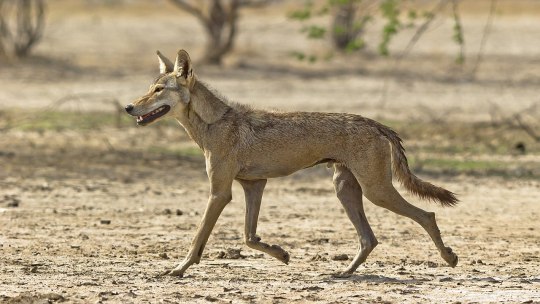
this is cuz they lack the big heavy fur coat that wolves normally have due to the warmer temperatures in their environment. wolves fur isnt really built for humid heat and theyre not skilled at hunting through heavy tree coverage, so if they did live in jungles theyd be on the edges or thinner areas probably. good luck writing!
136 notes
·
View notes
Text

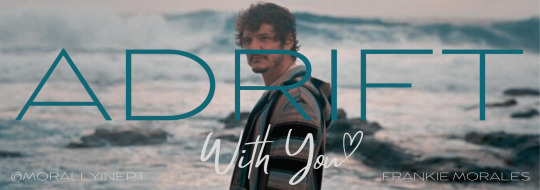
So, let's talk about the island...
I've had a few questions about it previously, so I've put this together to share my thoughts with you, in addition to the main Adrift With You story.
Read on if you wanna learn more about the island where Frankie & Jude washed up...
⚠️ This will include spoilers if you haven't read up to chapter 15 yet!


So, we know that Frankie and Jude boarded a flight from JFK New York, to Madagascar.
When I wrote this story originally (I wrote it a few years ago and re-worked it for Frankie), I already knew I didn't want them to be stranded on your typical tropical island.
Considering where they were heading, there isn't a lot of "tropical" islands in and around that part of the world. At least not in the sense of sandy white beaches, coral reefs, and the likes when you think of the word tropical.
You've got the main continent of Africa and then the Indian Ocean, with Madagascar on the southern-east side of Africa.
Here it is on a map:
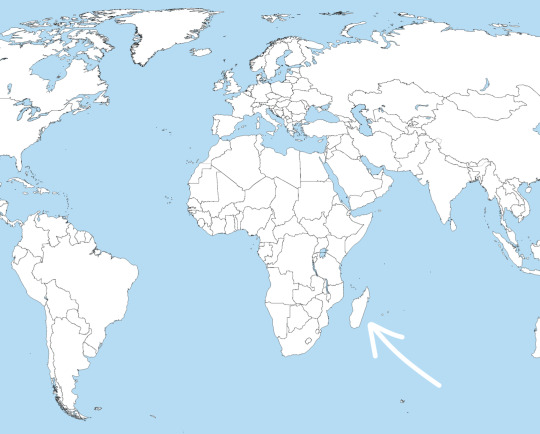
So, with that in mind, I researched some actual islands around the south tip of Africa, and we have The Prince Edward Islands and the Kerguelen Islands as some of the contenders.
The Prince Edward islands consist of two main islands and the Kerguelen are a group of scattered islands. Then you have the Crozet Archipelago in between. An Orion's Belt of islands, if you will...
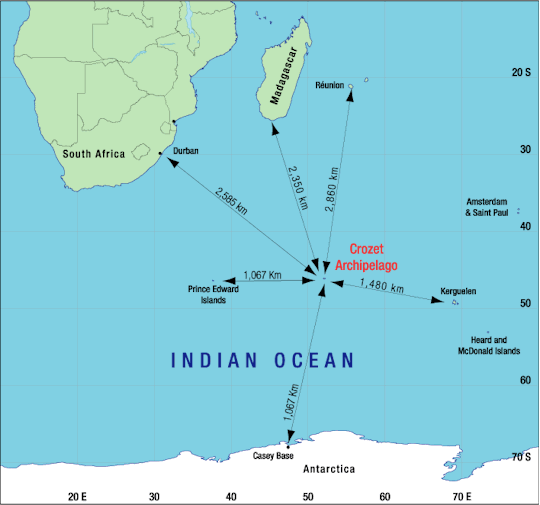
If you've read chapter 15 already, you'll know the pilots (Sandy & Mark) were checking their flight path as part of the pre-flight safety checks.
There was a storm cell gathering on the western side of Africa, that was around 140 miles in width. Storms, often between 100+ miles, are pretty intense and dangerous to fly through or close to, and have the ability to bring down planes with the winds alone.
Hence why pilots will re-route to divert around them. Which is exactly what poor ol' Sandy and Mark were doing when they met their fate.
Ordinarily, the flight path from JFK to Madagascar would involve flying over main land Africa, (the blue line, below) however they took to diverting around the storm, leaving them flying over the Atlantic Ocean (the red line).
Here's a little diagram I created of where the flight paths changed, location of the storm and the impact where the flight crashed.
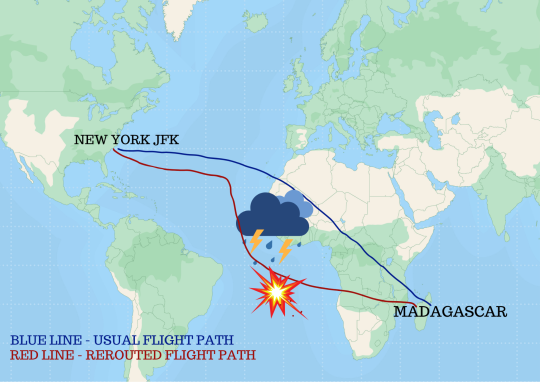
So, what caused the plane to crash? ✈️
Mechanical failure from the storm.
The most dangerous times for a plane to potentially crash is during take-off and landing, and the time periods before and after these events.
Pilot error is thought to account for 53% of aircraft accidents, with mechanical failure being 21%, and weather conditions at 11% following behind. So weather impacting flights is rare, however in the story, this is what caused the doomed flight to crash.
☝🏻You have a much better chance of survival if you sit at the rear of the plane, with just a 28% fatality statistic. 72% of the time you will survive. Impact dependant.
Jude was sitting at the rear. She's a smart woman.
Frankie however was further upfront towards the middle, with a 44% fatality rate.
Both of them survived the impact and the aftermath of the plane body subsequently sinking. Lucky, eh?
And guess who always sits at the rear of a plane when flying? 🙋🏻♀️
So, where did Frankie & Jude end up? 🏝
In my mind, Frankie and Jude washed up on an island somewhere around the vicinity of The Prince Edward Islands, but far enough away from them that they couldn't see the main two islands.
So, the island they were stranded on is entirely fictional.
It's inspired and based on the climate that's found on the Prince Edward and Kerguelen Islands, based on their locations in the southern hemisphere, vegetation and lack of inhabitation from humans and animals alike.
So Jett, where did Egon come from? 🐵
The Prince Edward Islands are uninhabited by humans, and previously used for conservation, this could explain why Egon the monkey was on the island. Some monkeys species can swim, like crab-eating macaques and proboscis monkeys, for example.
I figure that Egon could've either possibly swam between islands - although that's pretty far for a tiddly monkey - or he was able to get there by stowing away on passing boats, which is probably more feasible. That lil' scamp...
But what about the skeleton? 💀
I thought of several theories for the human remains that Jude found in the cave, ending up on the island, but ultimately settled on someone washing ashore and unable to get help.
Being alone would have been to their detriment. The fact that Frankie and Jude survived is due to leaning on one another and due to Frankie's military experience.
Being alone, without any survivalist skills to boot, your odds are significantly reduced.
Ultimately the person perished due to these reasons. The Naval Captain of the SS Pendrinhas alludes to this theory too in chapter 15.
So, why did it take so long for Frankie & Jude to be found? 🛳
I mean, it's a fictional story, for one. Gotta have some angst and drama, right? 😉
Both for those of you who like probability and fact, as the Captain states, the Navy crew on the SS Pendrinhas are based in Port Elizabeth, SA. They will help in search and rescue, and military missions.
When a plane crashes into the ocean, a search is usually conducted based around the immediate point of impact and where the black box last transmitted, or is found. They then work outwards, like a ripple effect.
In the ocean, water carries debris adrift, sometimes for hundreds, even thousands of miles. And depending on the tide, this can happen quite quickly too.
Both Frankie and Jude drifted further away from the crash sight, carried towards the island by the tide over the course of a whole day. Taking into account a number of factors, such as wind, tide etc... you could potentially drift hundreds of miles out.
It's also feasible that the search scoured any islands close by. Remember in chapter 8 when they spotted a boat on the horizon? However, without the means to create an obvious SOS signal, there would be no direct need to search for surviours there. The longer no survivors are found, the sooner the search is called off.
☝🏻Also, Frankie and Jude only had the fire burning on one side of the island; the smoke was obscured by the ridge, and the boat was spotted on the other side where the bay is.
🌊The tsunami is what ultimately saved them. Rescue efforts would have been ramped up across the ocean, especially around land masses, searching for capsizes or people becoming stranded in turbulent waters. Hence why Frankie saw the Naval boat and was able to signal for help.
It's all coming together now, huh? 😏
So, I hope that answers some questions about the island, and gives you a peek into my thought process. 🧠 If you wanna talk more about the island, or the story, (I'd love that!) feel free to send an Ask or leave a comment. 🙌🏻
And don't worry, Frankie and Jude have much more of their story to be told yet...

Once again, thank you so much to everyone who reads, interacts, re-blogs, but most importantly, enjoys this story. It means the absolute world to me. 🥹🖤
Adrift With You Series
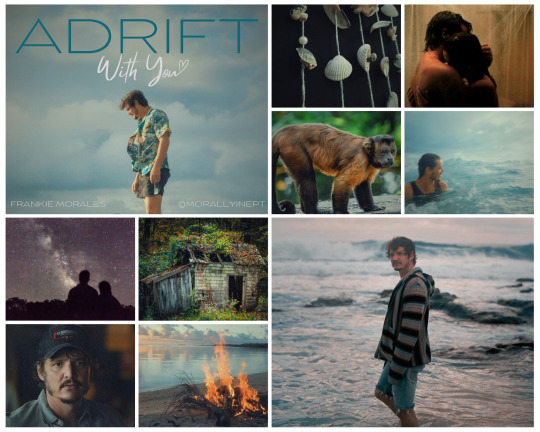

57 notes
·
View notes
Text
max's favorite short stories & articles!
to be updated as i read new things! "articles" could be anything from political points to philosophical musings to fascinating stories. obligatory statement that i don't necessarily agree with everything in every one of these stories/articles, but i think about them a lot and want to share :)
short stories
Avi Cantor Has Six Months To Live by Sacha Lamb (@kuttithevangu) (novella)
(so says the writing on the bathroom mirror. of gender & judaism & magic and t4t trans guys. cw for suicidal ideation and bullying)
Epistolary by Sascha Lamb
("The [stuffed] frog you are selling on your blog is MINE and he is NOT HAUNTED and his name is MOSHE not BILLY HOPPER.")
Chokechain by Andrew Joseph White
(a trans man discovers his parents have replaced him with a robot version of his pretransition self. cw for transphobia and violence)
Sandrine by Alexandra Munck
(the tagline for this one is "I dated a sun god in college" but that doesn't do justice to the sheer concept here please read this)
The Traveler Wife by yves. @yvesdot
(an astronaut writes to the wife she left back home)
You Wouldn't Have Known About Me by Calvin Gimpelevich
(set in a hospital ward where patients are recovering from gender-confirming surgery)
No Flight Without the Shatter by Brooke Bolander (novella)
("After the world’s end, the last young human learns a final lesson from Earth’s remaining animals." cw for climate change/extinction)
And You Shall Know Her By The Trail Of Dead by Brooke Bolander
(what if you had to death-match-fight a virtual version of yourself at your meanest made by your boyfriend whose life you're trying to save would that be fucked up or what. cws for guns and violence)
Hell is the Absence of God by Ted Chiang
(stories that clock you in the fucking teeth in the religious trauma.)
A Serpent for Each Year by Tamara Jerée (microfiction)
("Our relationship is almost a year old when I ask Nal why she is covered in snakes." cw for animal death)
The Front Line by W.C. Dunlap (microfiction)
(cited as one of the world's finest attention-grabber openings. cws for police brutality, racism, and SA)
Welcome to Your Authentic Indian Experience by Rebecca Roanhorse
(step into the simulation and gain an authentic experience! cws for anti-Native racism and alcohol)
articles & essays
Lockhart's Lament
(on how math is taught in schools. that is, badly. one of the most cathartic essays i've ever read on education)
Against Cop Shit by Jeffrey Moro
(on adversarial education)
I Am A Transwoman. I Am In The Closet. I Am Not Coming Out. by Jennifer Coates
(do you have to be out to be a woman? cw for transphobia, homophobia, and eating disorders)
Debunking "Trans Women Are Not Women" Arguments by Julia Serano
(comprehensive, well-written, good to have as a reference point)
On Liking Women by Andrea Long Chu
(and on the politics of desire)
Turning a Unicorn Into a Bat by Josh and Lolly Weed
(on Mormonism, love, and whether a gay man and a straight woman can marry happily. cw for homophobia)
Laziness Does Not Exist by Devon Price
(musings on motivation from a social psychologist and professor)
How Millennials Became the Burnout Generation by Anne Helen Peterson
(how come everything happens so much?)
White Women Drive Me Crazy by Aisha Mirza
(on the harm caused by white women. cw for racism)
Everything You Know About Obesity Is Wrong by Michael Hobbes
(should be required reading for everyone at this point. cw for fatphobia and eating disorders)
Becoming Anne Frank by Dara Horn
(on the cultural fascination with Anne Frank. cw for antisemitism)
The Ecstasy of Influence by Jonathan Lethem
([on/a] plagiarism)
On the Ethics of Boinking Animal People by Patricia Taxxon (video essay)
(ostensibly what the title says, but actually a detailed musing on the essential properties of furry media and the freedom of dehumanization; changed my life a bit)
#max.txt#yayayayayay :)#i've decided i'm going to start doing the 'what i read this month' thing#so this is like#my base to come backt o and update when i find new favorites#readings
69 notes
·
View notes
Text
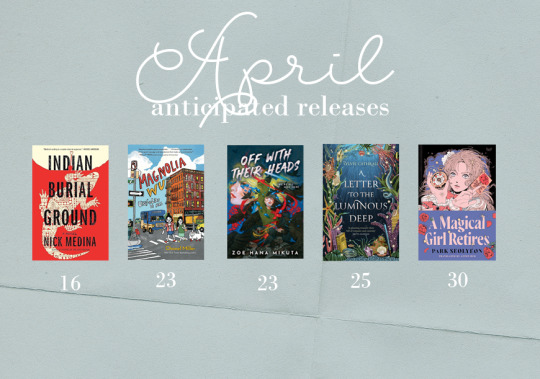
anticipated releases: april
(note: i have not yet read any of these and cannot speak to their quality- i’m just intrigued by the synopsis or author!)
Indian Burial Ground by Nick Medina - I don't know anything about this book except I LOVED Medina's last book Sisters of the Lost Nation. I love Indigenous horror/mystery.
Magnolia Wu Unfolds it All by Chanel Miller - a middle grade novel about a ten year old sock detective determined to return lonely socks left behind at her parents' laundromat. Written by Chanel Miller, whose Know My Name is one of the best memoirs ever written. So excited to see her explore fiction.
Off With Their Heads by Zoe Hana Mikuta - a sapphic, monster-filled story of betrayal and magic set in Wonderland.
A Letter to the Luminous Deep by Sylvie Cathrall - an epistolary novel set in a magical underwater world.
A Magical Girl Retires by Park Seolyeon, translated by Anton Hur - a depressed millennial woman turns into a magical girl and must fight climate change & credit card debt. TW for suicide mention in the synopsis.
24 notes
·
View notes
Text
https://www.nature.com/articles/d41586-023-01770-y

In India, children under 16 returning to school this month at the start of the school year will no longer be taught about evolution, the periodic table of elements or sources of energy.
The news that evolution would be cut from the curriculum for students aged 15–16 was widely reported last month, when thousands of people signed a petition in protest. But official guidance has revealed that a chapter on the periodic table will be cut, too, along with other foundational topics such as sources of energy and environmental sustainability. Younger learners will no longer be taught certain pollution- and climate-related topics, and there are cuts to biology, chemistry, geography, mathematics and physics subjects for older school students.
Overall, the changes affect some 134 million 11–18-year-olds in India’s schools. The extent of what has changed became clearer last month when the National Council of Educational Research and Training (NCERT) — the public body that develops the Indian school curriculum and textbooks — released textbooks for the new academic year that started in May.
...
Aditya Mukherjee, a historian at Jawaharlal Nehru University in New Dehli, says that changes to the curriculum are being driven by Rashtriya Swayamsevak Sangh (RSS), a mass-membership volunteer organization that has close ties to India’s governing Bharatiya Janata Party. The RSS feels that Hinduism is under threat from India’s other religions and cultures.
“There is a movement away from rational thinking, against the enlightenment and Western ideas” in India, adds Sucheta Mahajan, a historian at Jawaharlal Nehru University who collaborates with Mukherjee on studies of RSS influence on school texts. Evolution conflicts with creation stories, adds Mukherjee. History is the main target, but “science is one of the victims”, she adds.
#india#science#anti-science#evolution#education#authoritarianism on the rise#religious fanaticism#cultural regression#hindu extremism#anti-intellectualism#a new dark age always travels by our side
104 notes
·
View notes
Note
Can you explain the Hyperboera theory please? Is it the white people version of the Yakub thing?
The Hyperborea theory is actually more based in reality than the fantasy of Yakub, and like all good things, we begin with Greek Myth.
In Greek myth, Hyperborea was a land located to the far north of the known world, it was so remote it was considered even beyond the North Wind.
There a legendary race known as the Hyperboreans lived, and worshipped the sun god Apollo.
Herodotus wrote that the 7th century BC, the poet Aristeas wrote of the Hyperboreans in a poem called Arimaspea, about a journey to the Issedones, who are estimated to have lived in the Kazakh Steppe.
Beyond these lived the one-eyed Arimaspians, further on the gold-guarding griffins, and beyond these the Hyperboreans.
Herodotus assumed that Hyperborea lay somewhere in Northeast Asia.
Homer placed Boreas in Thrace, and therefore Hyperborea was in his opinion north of Thrace, in Dacia.
Heraclides Ponticus and Antimachus in contrast identified the Riphean Mountains with the Alps, and the Hyperboreans as a Celtic tribe (perhaps the Helvetii) who lived just beyond them.
Aristotle placed the Riphean mountains on the borders of Scythia, and Hyperborea further north.
Hecataeus of Abdera and others believed Hyperborea was Britain.
Later Roman, and Greek sources continued to change the location of the Riphean mountains, the home of Boreas, as well as Hyperborea, which was supposedly located beyond them.
However, all of the sources agreed the locations of the mountains and Hyperborea were far north of Greece and southern Europe.
Simmias of Rhodes in the 3rd century BC connected Hyperborea to the Massagetae and Posidonius in the 1st century BC to the Western Celts, but Pomponius Mela placed them even further north in the vicinity of the Arctic.
This final connection was what stuck in the minds of those who would later propose a location for Hyperborea.
However, later writers disagreed on the existence and location of Hyperborea, with some regarding it as purely mythological, and others connecting the Hyperboreans to real-world peoples and places in northern Eurasia (ie. Britain, Scandinavia, or Siberia).
In medieval and Renaissance literature, the Hyperboreans came to signify remoteness and exoticism.
Modern scholars consider the Hyperborean myth to be an amalgam of ideas from ancient utopianism, "edge of the earth" stories, the cult of Apollo, and exaggerated reports of phenomena in northern Europe known as the Arctic or "midnight sun."
Since Herodotus places Hyperborea beyond the Massagetae and Issedones, both Central Asian peoples, it appears that his Hyperborea may have been in Siberia.
Heracles sought the golden-antlered hind of Artemis in Hyperborea. As the reindeer is the only deer species of which females bear antlers, this would suggest an arctic or subarctic region.
This has led some to believe that the Chinese are Hyperboreans, while others deny this as Reindeer also appear in Northern Europe, meaning Heracles could have sought the thr golden-antlered hind of Artemis in Scandinavia, meaning Hyperborea could have been Norse.
It would be this connection that stuck.
Hyperborea in Greek myth however was not an icy land, it was a warm, sunny land that existed beyond Boreas, who was credited for creating cold climates.
However, the idea of Hyperborea being in the Arctic is the idea that stuck.
Now, this ask was in context to the Indo-European hypothesis, which stipulates that the people who became Indo-Europeans came from Hyperborea, which is correct and incorrect, while yes, the Indo-European people's all come from the same tribal lineage, we did not emerge from the Arctic during an ice age.
Now, this idea stuck itself in the minds of both Russian and Indian nationalists, this was inspired by the works of Bal Gangadhar Tilak in his The Arctic Home in the Vedas, and the Austro-Hungarian ethnologist Karl Penka in his Origins of the Aryans.
Soviet Indologist Natalia R. Guseva and Soviet ethnographer S. V. Zharnikova, influenced by the works, argued for a northern Urals Arctic homeland of the Indo-Aryan and Slavic peoples.
This never caught on outside of Russia and India.
All of this, right now, is plausible, Indo-European people's did come from the same tribal bands of Proto-Indo-Europeans that swept across, and subsequently conquered Eurasia, and North Africa, they did originate from either the steppes of central Asia or the mountains of eastern Europe, their land would have been an alien landscape to the ancient Greeks who would hear of this land beyond Boreas through oral traditions, and so on.
Now, we get into the part that makes the Hyperborea theory, like the Yakub theory, and like all absurd things, we can thank the French.
Robert Charroux first related the Hyperboreans to an ancient astronaut race of "reputedly very large, very white people" who had chosen "the least warm area on the earth because it corresponded more closely to their own climate on the planet from which they originated".
This stuck, and then evolved over the decades to become the modern Hyperborea meme, which claims white people were created, or are aliens, destined to rule the world from beneath the Arctic, or the moon, and the Nazis are also there;
24 notes
·
View notes
Text
“Knowing You Has Made Me a Better Settler Person”: Tokenizing the Métis Identity
View my work: A Spectacle of Me for You
By riel
My name is riel, I am a Red River Métis artist descending maternally from the historic Métis families by the names of Berthelet, Caron, St. Germaine, Dubois, Dazé, and Larivière, who come from the communities of Pointe à Grouette, now St. Agathe, St. Norbert, and St. Vital, now modern-day Winnipeg, and the historic Batoche, Saskatchewan. My Berthelet ancestors, notably my third great grandfather Joseph Berthelet Sr. was a community leader of Pointe à Grouette, and my fifth-great uncle Jean Caron Sr fought at fifty-two years old in the battle of Duck Lake, Saskatchewan of the North-West Resistance of 1885. His house is now a historic site in Batoche. My mother is a Métis academic with a background in education and my father is a settler of British ancestry, and an archaeologist-turned-locksmith. I introduce myself in this way, in the traditional way of Métis authors, such as Chantal Fiola and Jean Teillet, to contextualize my knowledge and experiences, as well as my connection to this land.
Earlier this year, 2022, as the winter semester wrapped up, and spring was beginning to rear its big green head, I finished building a Red River cart. It was four months of research and physical labour. I taught myself methods of wood joinery that my ancestors would have used, the hand tools they had access to pre-industrial revolution, as well as the power tools we as modern Métis have access to now. After the cart’s completion I installed it in the Ivan Gallery at school. That is when and where it happened. A classmate of settler colonial ancestry approached me. We had spent two semesters at odds. Her work focused on the climate crisis but came from a place of doomism and borderline eco-fascism. She regurgitated colonial narratives regarding our “doomed world” and the inherent violence of humans, and when she was corrected and shown the harm in her words she doubled down.
She said to me “knowing you, has made me a better person.” I do not know this woman and she does not know me, but I believe I knew her in that moment. To her, I am an encyclopedia, a fountain of knowledge for her to drink from whenever she wants to feel a little less guilty. I realized what she meant.
“Knowing you has made me a better settler person”
What does it take to know a person? Who defines knowing? In that moment, I knew my classmate, but she could not have known me less. To her, and many others I have met in my life, my culture and I represented an outlet for settler guilt. I was the “real Indian” she took a photo with to prove her proximity and understanding of Indigeneity (James Luna). Because in settler minds, every Indian is every Indian, and every Indian is an encyclopedia to test knowledge against. I am a measuring stick for settlers to compare their thoughts and actions to.
I began to really consider how settlers were tokenizing me; sexually, intellectually, culturally, spiritually, to settlers I am a fantasy Métis academic. I am an all knowing all sensing wise Indian who can track a man through all terrains, who can tell you your spirit name by just looking at you, who will save your life when you are caught unprepared on my land, and who will scalp an enemy with no mercy. That is what people want from me, not the stories of the Métis resistance leaders who tried to overtake your settler ancestors in the Northwest Resistance, who could spit bullets and toss gunpower directly into their guns all while on horseback. They do not want to hear about The Old Wolves who fought in the Northwest Resistance and years later met in St. Vital to lovingly and meticulously document our young nation’s history, who hated the word “rebellion” (Jean Teillet).
A Spectacle of Me for You is an installation containing a series of sculptures, photographs, prints, and found objects arranged in a “spectacle” of the Métis identity. The work is the result of experimentation with materials and engagement with Métis theory on self-governance and our history. Being named after Louis Riel often feels like an invitation for settlers to give me their unsolicited opinion on whether my ethnic group should have rights, and if Louis Riel was a madman or not, with most of the conversations quickly becoming anti-Indigenous and/or ableist. To my people, however, it is an honour to be named after Riel, the man who, with Gabriel Dumont successfully won the Red River Resistance of 1869, and commanded my ancestors in the Northwest Resistance of 1885. In this work I employ Indigenous humour- our ability to make fun of ourselves, remaining in control of the joke in order to remove that power from settlers, who are suddenly uncomfortably aware of their perception of Indigenous peoples. I have been heavily influenced by artists like Jesse Ray Short who dressed as Louis Riel in a drag-esque performance, and James Luna’s performance Take A Picture with a Real Indian (2001) and Artifact Piece (1987), Dayna Danger’s Big ‘Uns series, specifically for their reclamation of explicit Indigenous sexuality, and their ways of incorporating Indigenous, specifically Métis and Salteaux material culture into representations of Indigenous sexuality. Finally, I also would like to reference Rebecca Belmore’s piece Artifact #671B from 1988, where Belmore implicates her own body as an artifact in similar ways that James Luna has.
The viewer enters the room to find a table at the back of the room, seemingly an in-use workspace, with a sewing mannequin dressed in brown pants, a red and black flannel, a Louis Riel shirt, and a beaded leather strap on placed over the pants. There is also a half-deflated mask of Louis Riel placed on the table. On the table there are postcards- free for the viewer to take with two different designs to choose from. On one side of the room a log has been placed on the ground and another rests a few feet away, seemingly more haphazardly than the carefully placed log.
A Spectacle of Me for You is a staged representation of what a beader’s workspace might look like. A series of props that vaguely reference the Métis but does not actually represent the workspace of the artist. It is a highly curated idea of the Métis identity, playing on well-known stereotypes. Among the workspace set-up there are two stacks of postcards, one with a shot of the artist posing with two logs they personally harvested in January of 2022, left over from building a Red River cart, one of the logs positioned suggestively between the legs of the artist. They are dressed in stereotypical lumberjack clothes as well as a t-shirt with Louis Riel’s face and a slogan that reads “keepin’ it Riel”. The artist also wears a latex mask of Louis Riel, tying the fantasy together.
Otipemisiwak Voyageur Fantasy Husband is a series of postcards as well as a costume worn by the artist to comment on different aspects of tokenization. The leather strap on harness worn over their clothes is an overt reference to the fetishization of Indigenous people, specifically Indigiqueer and Two Spirit community members, and a comparison of Indigenous and settler masculinity. The harness is paired with a lumberjack style flannel and a shirt with an image of Louis Riel that reads “keepin it real”, and a latex mask of Riel, worn on the artist’s head, obscuring their face. The postcards and the mask are a reference to modern Métis material culture and our infatuation with objects with Louis Riel’s face. The mass-production of these items has both caused a massive inflation of Louis Riel-kitsch, but also a larger awareness of our presence as Métis people, and what Riel means to us. Akin to the presidents' masks used by the Ex-Presidents gang in the 1991 film Point Break, the artist uses their Riel mask to draw attention to the way real historical figures, particularly politicians become caricatures of their actual selves in the eyes of the public, allowing them to be immortalized in popular culture. On a smaller scale, something similar has happened to Louis Riel where many settlers deem him a violent mad-man, and reduce him to a caricature of himself, while the Métis have reclaimed this treatment, and have found ways to honour him in our material culture.
References/Works Cited
BELMORE, REBECCA. ARTIFACT #671B, 1988.
BIGELOW, KATHRYN. POINT BREAK. TWENTIETH CENTURY FOX, 1991.
BURNS, CLARISSA. VOYAGEUR GAMES DEMONSTRATION. https://metisgathering.ca/classroom-resources/classroom-voyageur-games/. MÉTIS GATHERING. 2022.
LUNA, JAMES. TAKE A PICTURE WITH A REAL INDIAN, 2000.
LUNA, JAMES. ARTEFACT PIECE, 1987.
RIEL, LOUIS. FINAL TRIAL STATEMENT. http://law2.umkc.edu/faculty/projects/ftrials/riel/rieltrialstatement.html. JULY 31ST 1885.
SHORT, JESSIE RAY. WAKE UP!, 2015.
TEILLET, JEAN. THE NORTH-WEST IS OUR MOTHER : THE STORY OF LOUIS RIEL’S PEOPLE, THE METIS NATION. PATRICK CREAN EDITIONS, AN IMPRINT OF HARPERCOLLINS PUBLISHERS LTD., 2013.
#my writing#context for some of my work! but this could probably stand alone#linking the work at the top!#indigenous academic#indigenous#métis#métis writer#art writing#artist statement
135 notes
·
View notes
Text
Biden to Designate Monument Near Grand Canyon, Preventing Uranium Mining
Uranium extraction had already been restricted in the area, which Native tribes consider sacred, but the moratorium was set to expire in 2032. Mr. Biden’s designation will make it permanent.
(The New York Times, 8/8/23) President Biden will designate nearly a million acres of land near the Grand Canyon as a new national monument on Tuesday to protect the area from uranium mining, administration officials confirmed on Monday.
Mr. Biden’s visit to Arizona is part of a nationwide blitz by the White House to translate key policy victories to voters — including a law he signed last year to inject $370 billion in tax incentives into wind, solar and other renewable energy — as the 2024 campaign ramps up. Senior cabinet officials are also touring the country this week, highlighting his domestic agenda.
During his first stop of a three-state tour, Mr. Biden will announce that he is creating a national monument — the fifth such designation of his presidency — in an area sacred to Native American tribes, administration officials told reporters on Monday.
“The mining is off limits for future development in that area,” Ali Zaidi, Mr. Biden’s national climate adviser, told reporters on Air Force One. “It’s focused on preserving the historical resources” in the area.
Native tribes and environmental groups have long lobbied for the government to permanently protect the area around the Grand Canyon from uranium mining, which they say would damage the Colorado River watershed as well as areas with great cultural meaning for Native Americans.
Under the proposed designation, all new uranium mining will be blocked. Uranium mining has already been restricted in the area in question since 2012, but that Obama-era moratorium was set to expire in 2032. Mr. Biden’s designation would make the conditions permanent.
Mr. Biden’s visit to Arizona was also an effort to energize crucial constituency groups in the state, even as much of the American public remains skeptical of his domestic agenda.
Mr. Biden has called the Inflation Reduction Act — major legislation he signed last year that aims to cut planet-warming greenhouse gas emissions — “the largest investment ever in clean energy.” Yet 71 percent of Americans say they have heard “little” or “nothing at all” about the package one year later, according to a Washington Post-University of Maryland poll.
And most Americans — 57 percent — disapprove of his handling of climate change, according to the poll. Surveys show young voters, who turned out in force during the 2020 election, are particularly concerned about global warming.
Some environmental groups were left infuriated when Mr. Biden greenlit a drilling project known as Willow on pristine federal land in Alaska and mandated the sale of offshore drilling leases as part of a deal to pass the climate bill, undermining a campaign promise to ban drilling on federal lands.
“We know that polls don’t tell the entire story,” Karine Jean-Pierre, the White House press secretary, said on Monday when asked about why voters seemingly do not know what it is in Mr. Biden’s bills. As the administration continues to enact the various legislative packages, she said, “we’ll see Americans start to feel what we’ve been able to do in Washington.”
Native Americans were also a crucial voting bloc in Arizona in 2020, when the state voted for a Democratic presidential candidate for the first time since 1996. They made up 6 percent of Arizona’s electorate in 2020, larger than Mr. Biden’s margin for victory, according to the National Congress of American Indians.
More than 80 percent of Native American voters in 2020 agreed with the statement that “the federal government should return lands stolen from Native American tribes,” according to a 2022 poll conducted by the African American Research Collaborative.
“It is likely a strategic decision to focus on the Grand Canyon,” said Gabriel Sanchez, a fellow at the Brookings Institution who has researched voting trends among Native Americans.
“Many Native Americans do not vote based on party, but on which candidates will do the most to advance the interests of Native American communities.”
The National Mining Association called the monument designation “unwarranted” and said it would force the United States to rely on imported uranium from countries like Russia. Representative Bruce Westerman, Republican of Arkansas and the chairman of the House Committee on Natural Resources, blasted Mr. Biden for locking up domestic resources.
“This administration’s lack of reason knows no bounds, and their actions suggest that President Biden and his radical advisers won’t be satisfied until the entire federal estate is off limits and America is mired in dependency on our adversaries for our natural resources,” Mr. Westerman said in a statement.
The administration has argued that the proposed monument represents only 1.3 percent of the nation’s known uranium reserves.
“This is going to be a limit on future development in this space while being respectful of existing rights,” Mr. Zaidi said.
The area in question is called Baaj Nwaavjo I’tah Kukveni — Baaj Nwaavjo, meaning “where tribes roam,” for the Havasupai people, and I’tah Kukveni, or “our footprints,” for the Hopi tribe.
Earlier this year Mr. Biden created a new national monument, Spirit Mountain, in Nevada, insulating from development a half-million acres that are revered by Native Americans. He also restored and expanded protections for Bears Ears National Monument and Grand Staircase-Escalante in Utah, sites that are sacred to Native Americans and that had been opened to mining and drilling by the Trump administration.
In June, the Biden administration banned drilling for 20 years around Chaco Canyon in New Mexico, one of the nation’s oldest and most culturally significant Native American sites. (Source)
32 notes
·
View notes
Text

New SpaceTime out Friday....
SpaceTime 20240112 Series 27 Episode 6
Distant stars spotted in the Magellanic Stream for the first time
Astronomers have discovered 13 stars with in the Magellanic stream a colossal ribbon of high velocity neutral hydrogen gas spanning the Magellanic Cloud galaxies which are two of our Milky Way galaxy's closest cosmic neighbours.
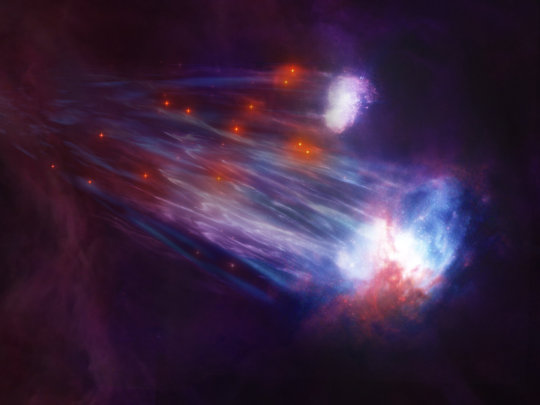
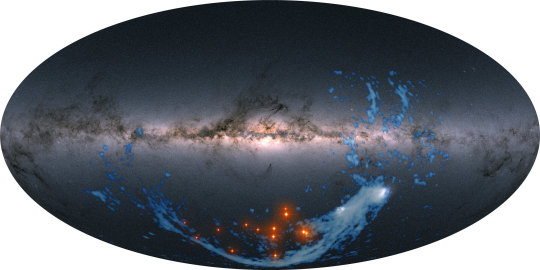
NASA begins testing its new Shooting Star
With the first completed Dream Chaser space plane Tenacity now under testing at NASA's Neil Armstrong Test Facility in Ohio in preparation for its first orbital flight to the International Space Station – the first completed shooting star model which will be attached to the space plane -- has now also commenced a comprehensive testing campaign at the facility.






NASA’s Deep Space Network turns 60
NASA’s Deep Space Network which provides critical communications and navigation services to dozens of space missions and support to dozens more has just celebrated its 60th birthday.



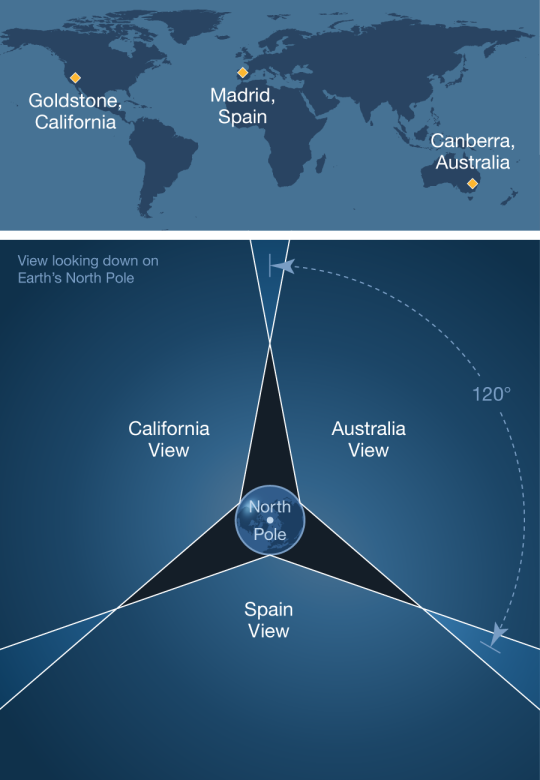


The Science Report
How vigorous exercise can reduce your risk of Alzheimers.
Droughts will become more frequent and more severe under climate change.
Claims that living at home with your parents well into adulthood is not good for your mental health.
Skeptics guide to Indian pseudoscience on the rise
SpaceTime covers the latest news in astronomy & space sciences.
The show is available every Monday, Wednesday and Friday through Apple Podcasts (itunes), Stitcher, Google Podcast, Pocketcasts, SoundCloud, Bitez.com, YouTube, your favourite podcast download provider, and from www.spacetimewithstuartgary.com
SpaceTime is also broadcast through the National Science Foundation on Science Zone Radio and on both i-heart Radio and Tune-In Radio.
SpaceTime daily news blog: http://spacetimewithstuartgary.tumblr.com/
SpaceTime facebook: www.facebook.com/spacetimewithstuartgary
SpaceTime Instagram @spacetimewithstuartgary
SpaceTime twitter feed @stuartgary
SpaceTime YouTube: @SpaceTimewithStuartGary
SpaceTime -- A brief history
SpaceTime is Australia’s most popular and respected astronomy and space science news program – averaging over two million downloads every year. We’re also number five in the United States. The show reports on the latest stories and discoveries making news in astronomy, space flight, and science. SpaceTime features weekly interviews with leading Australian scientists about their research. The show began life in 1995 as ‘StarStuff’ on the Australian Broadcasting Corporation’s (ABC) NewsRadio network. Award winning investigative reporter Stuart Gary created the program during more than fifteen years as NewsRadio’s evening anchor and Science Editor. Gary’s always loved science. He studied astronomy at university and was invited to undertake a PHD in astrophysics, but instead focused on his career in journalism and radio broadcasting. He worked as an announcer and music DJ in commercial radio, before becoming a journalist and eventually joining ABC News and Current Affairs. Later, Gary became part of the team that set up ABC NewsRadio and was one of its first presenters. When asked to put his science background to use, Gary developed StarStuff which he wrote, produced and hosted, consistently achieving 9 per cent of the national Australian radio audience based on the ABC’s Nielsen ratings survey figures for the five major Australian metro markets: Sydney, Melbourne, Brisbane, Adelaide, and Perth. The StarStuff podcast was published on line by ABC Science -- achieving over 1.3 million downloads annually. However, after some 20 years, the show finally wrapped up in December 2015 following ABC funding cuts, and a redirection of available finances to increase sports and horse racing coverage. Rather than continue with the ABC, Gary resigned so that he could keep the show going independently. StarStuff was rebranded as “SpaceTime”, with the first episode being broadcast in February 2016. Over the years, SpaceTime has grown, more than doubling its former ABC audience numbers and expanding to include new segments such as the Science Report -- which provides a wrap of general science news, weekly skeptical science features, special reports looking at the latest computer and technology news, and Skywatch – which provides a monthly guide to the night skies. The show is published three times weekly (every Monday, Wednesday and Friday) and available from the United States National Science Foundation on Science Zone Radio, and through both i-heart Radio and Tune-In Radio.
#science#space#astronomy#physics#news#nasa#esa#astrophysics#spacetimewithstuartgary#starstuff#spacetime
10 notes
·
View notes
Text

[ID: A jar half-full of a dark gold liquid. Dried herbs are scattered on the table around it. End ID.]
Niter kibbeh / ንጥር ቅቤ (Ethiopian clarified butter)
Niter kibbeh is a butter clarified with herbs and spices. It is commonly used in Ethiopia and Eritrea to add a fresh, robust, well-rounded flavor to meat dishes. Some less traditional recipes include it in Ethiopian lentil stews or use it as a cooking oil; you might also use it in place of ghee or a tadka to lend additional flavor to Indian dishes, or stir it into any soup, stew, or chili to add aroma.
This recipe is for a typical Ethiopian preparation that does not skip steps or rely on undisclosed substitutions of herbs and spices; however, substitutions are suggested for those without access to Ethiopian herbs.
Recipe under the cut!
Patreon | Tip jar
Makes about 1/2 cup.
Ingredients:
For the butter:
2 cups (460g) unsalted butter, ghee (Indian clarified butter), or smen (Moroccan clarified butter)
For a vegan version, use vegan ghee, vegan cultured butter, non-dairy margarine, or refined coconut oil.
Clarified butter and coconut oil contain less water than butter or margarine, so you may have a slightly higher yield with these bases (or reduce your starting amount to 1 3/4 cup). I tested this recipe with 2 cups of Earth Balance stick margarine.
For the manteria:
1 garlic clove
2 cm chunk ginger
1 cm chunk fresh turmeric root, or pinch of ground turmeric (optional)
A few slices shallot or red onion
2 Tbsp (1.5g) dried koseret (ኮሰረት)
2 Tbsp (2.3g) dried Ethiopian holy basil (besobela / በሶቢላ), or one sprig fresh besobela
1 Tbsp Ethiopian false cardamom (korerima / ኮረሪማ)
2 tsp fenugreek seeds (abish or hulbet / አብሽ)
2 tsp nigella seeds (tikur azmud / ጥቁር አዝሙድ)
2 tsp carom seeds (netch azmud / ነጭ አዝሙድ)
Pinch of salt
The "kibbeh manteria" / ቂቤ ማንጠሪያ (or "ye kibe kimem") is the blend of herbs and spices added to the butter while it’s clarifying—the verb "manter" means "to clarify." Each cook has their own preferred manteria recipe, but they are commonly made of some combination of shallot, ginger, garlic, korerima, nigella seeds, carom seeds, fenugreek, besobela, koseret, rosemary, and turmeric.
See notes on spices and herbs at the end.
Instructions:
Niter kibbeh is usually made using clarified fermented butter. If you're starting from a base of ghee or smen (clarified fermented butters which may be readily purchased at halaal grocery stories in the U.S.A. and Europe) or vegan fermented butter, all you need to do is heat the butter with the manteria and then strain. If you're starting from a base of fresh butter, you might choose to ferment it yourself for about a month, or skip this step. I have not tested the fermentation step with non-dairy margarine.
1. Dark-roast the fenugreek. Heat a dry skillet over medium. Roast fenugreek, agitating occasionally, until it has considerably darkened to a medium brown. Set aside and allow to cool. Gring using a mortar and pestle or spice mill.
2. Ferment the butter. If using fresh butter, allow it to soften at room temperature and mix it with a teaspoon of fenugreek and about a tablespoon of koseret until well-combined. Allow to mature in a sealed container at room temperature for 30-40 days, until it is very soft and smooth and smells pungent and well-fermented. This will take longer in a cold climate than a hot one.
Make sure that your storage container and anything else that will touch the butter are clean and dry, and that the container is airtight. If the butter develops mold, discard it.
3. Prepare the wet mixture. Peel and crush garlic, ginger, shallot or onion, and fresh turmeric into a paste using a mortar and pestle. If your besobela is fresh rather than dried, crush it along with the aromatics at this point.
4. Prepare the dry mixture. Coarsely crush dried herbs and spices in a mortar and pestle or spice mill.
5. Make the niter kibbeh. Heat butter, margarine, or coconut oil on medium until melted. Add dry spices and herbs and cook, stirring often, until simmering. You will know when dairy butter is ready for you to proceed to the next step because its foam will dissipate.
6. Add wet herbs and aromatics and lower heat to low. Cook, stirring often, for about 10 minutes or until fragrant. Take off the heat and allow to cool.
7. Strain through a cheesecloth and store in an airtight container, refrigerated, for up to several months. The niter kibbeh will solidify in the fridge.
Notes on spices and herbs:
Besobela
Ethiopian holy basil is a subspecies of basil whose flowers have a distinctive fruity or tea-like aroma. Dried besobela may be purchased online.
Some recipes call for basil or oregano in place of besobela, but to my nose the aroma of besobela is more akin to that of camomile; you might use a mixture of basil and camomile.
Korerima
Korerima, also known as “grains of paradise,” “black cardamom,” or “false cardamom,” is the seed of a plant in the ginger family. Some recipes mistakenly call for Nepal cardamom in place of korerima, because Nepal cardamom is also known as “black cardamom” in English. The aroma of korerima once ground, though, is much more akin to that of green cardamom than to the smoky, camphorous aroma of Nepal cardamom; I would suggest green cardamom as a substitution.
Some niter kibbeh recipes use both the seed and seed pods of 'unhulled' korerima.
Netch azmud
Carom seeds may be found in any halaal grocery store, where they will be labelled "ajwain." You may also see these referred to as “white cumin” or “caraway seeds” in English, but don’t confuse them with true caraway seeds (Carum carvi), which are larger.
Tikur azmud
Because “tikur azmud” literally translates to “black cumin” in English, some recipes make the mistake of calling for kala jeera (Indian black cumin)—however, the seeds are from different plants entirely. “Tikur azmud” refers to the seeds of the Nigella sativa plant, which are known as nigella seeds in English cooking and kalonji in Indian cooking.
Koseret
Koseret, Lippia abyssinica, is a species of plant in the verbena family with a mint-like, camphorous aroma. Dried koseret may be found at a specialty spice store, or online.
Koseret has antibacterial properties which aid in preserving butter; I have not tested fermenting butter without it. You might try a mixture of dried mint and basil as a substitution, but check on the butter frequently if you are fermenting it.
45 notes
·
View notes
Text
Ladies please reblog to spread the word about these ladies and their fight to protect their homes from the destruction of the Oil industry

BY NEMONTE NENQUIMO AND NONHLE MBUTHUMA
DECEMBER 15, 2022 7:00 AM EST
Nenquimo, co-founder of Amazon Frontlines and the Ceibo Alliance, is a Waorani leader who has won the Goldman Environmental Prize. Mbuthuma is a leader of the amaMpondo people in South Africa and spokesperson of the Amadiba Crisis Committee, a collective that defends her community’s rights to steward their ancestral land.
We are two Indigenous women leaders writing from the frontlines of the battle to save our oceans, our forests, and our planet’s climate. We have good news to share: We know how to beat Big Oil.
From the Amazon rainforest to the shores of the Indian Ocean in South Africa, we have led our communities to mighty victories against oil companies who hoped to profit off our territories. In September 2022, we succeeded in getting a court to revoke a permit that would have allowed Shell to despoil Indigenous farming communities and fishing grounds along the pristine Wild Coast of South Africa. Just a few years earlier in April 2019, we organized Indigenous communities deep in the Ecuadorian rainforests to resist the government’s plans to drill in pristine rainforests and were victorious, protecting half a million acres of forests and setting a legal precedent to protect millions more.
Both were David vs. Goliath victories—and both were opportunities for us to learn where to point that fabled slingshot.
Big Oil has the deepest of pockets and a horrific track record when it comes to corruption, scandal, and environmental crimes. Across the world, Indigenous and local communities know that once the industry gets a foothold in our lands, it leaves ruin in its wake. For instance, the A’i Cofán people of Ecuador’s northern Amazon have borne the brunt of decades of oil industry contamination, deforestation, and health impacts. And the Ogoni people of the Niger Delta have lost their fishing and farming lands to polluting oil operations, and have seen their leaders threatened and murdered when they dared to speak out.
As frontline communities, we must work together to stop Big Oil before they enter our lands. But this, in itself, is no easy task. The industry offers alluring promises of “progress” and “development.” And they have people—in government, the military, police forces, shadowy paramilitary groups, and sometimes in our own communities—who are willing to intimidate, harass, and even kill leaders like us who have the courage to stand up to them. They also have billions of dollars riding on getting permits to suck the oil out of the ground and sea.
So, how did we stop them?
First, we kept our communities together. We fought against the industry’s “divide and conquer” tactics by grounding our battle in our own sacred connection to our lands. Our ancestors and elders understood, as we do today, that Mother Earth is sacred and worth fighting for. We are connected to her through our breath, our stories, our dreams, and our prayers. She gives us everything: water, food, medicine, shelter, meaning. And in return, we protect her.
We also helped our people cut through the false promises and threats by exposing Big Oil’s lies and abuse around the world. That is, we made sure our villagers could learn from the A’i Cofán people of Ecuador, the Ogoni of the Niger delta, and the countless other frontline communities that have suffered at the hands of Big Oil.
As Indigenous women leaders, we know that if we can keep our sacred connection to the land and keep our people united, then we have a fighting chance against any oil company in the world.
We also have the law on our side, which makes Big Oil really vulnerable. In 2007, the U.N. General Assembly adopted the United Nations Declaration on the Rights of Indigenous Peoples, which recognized our right to Free, Prior, and Informed Consent (FPIC) for any activity that affects our ancestral lands. Our shorthand is “Nothing About Us Without Us.” We, Indigenous peoples, the ancestral owners of some of the most biodiverse, carbon-rich places on the planet (the places that the oil industry wants to get their hands on more than anything), have the internationally recognized legal right to decide what happens on our land.
In South Africa, we were able to protect 6,000 square miles of pristine marine ecosystems off the Wild Coast, saving dolphins and whales from deafening seismic blasts on the ocean floor while also protecting local communities and our planet’s climate from the threat of ramped-up offshore drilling. And on the other side of the world, in Ecuador, we leveraged our internationally recognized rights to protect some of the biodiverse rainforest in the Amazon, jamming the Ecuadorian Government’s plans to drill across millions of acres of Indigenous territories.
But the law alone isn’t enough. To move courts and politicians—and to create legal exposure and reputational risk to companies—we need global community support to keep going.
That means getting financial resources to the frontlines, so that we can protect our leaders, organize our communities, and secure our rights. Only a fraction of 1% of all climate funding currently makes it to Indigenous communities on the frontlines of the climate battle. We need to change that.
It also means sharing our stories and shining a spotlight on our struggles, so that local courts and politicians know that the world is watching. Public solidarity not only prevents corruption and back-room deals, but it also energizes our grassroots campaigns.
We need to continue to pressure governments around the world to finally adopt our internationally recognized right to decide what happens in our lands in their national laws and constitutions. Our peoples have been putting our bodies on the line in the battle to protect Mother Earth for centuries. It’s not only a moral imperative that global governments finally recognize and respect our right to self-determination, but it is also one of the most urgent and effective climate strategies—it’s no coincidence that we are the guardians of over 80% of our planet’s biodiversity. In the Amazon rainforest, half of the remaining standing forest is in our territories. Without us and without our territories, there is no climate solution.
To have a fighting chance of keeping global warming below 1.5 degrees Celsius, we can’t afford to be opening up new oil fields in the lungs of the earth. We need to keep our forests standing. We need to transition to renewable energy.
We are writing this because we see that world leaders, businesses, and NGOs are only making slow, incremental progress on climate despite the urgent existential threat we face. Instead of getting frustrated, we’re doubling down on sharing our formula with other Indigenous guardians on the ground.
We know that time is not on our side—but our spirituality and our rights are. So here’s one idea from two Indigenous women leaders that beat the oil industry, and protected our oceans and our forests: Listen to us for a change.
#Indigenous Women#Big Oil#Amazon Frontlines#Ceibo Alliance#Inspiring Women#Alexandra Narváez#Cofan#Ecuador#Climate change#protecting rainforests
60 notes
·
View notes
Photo
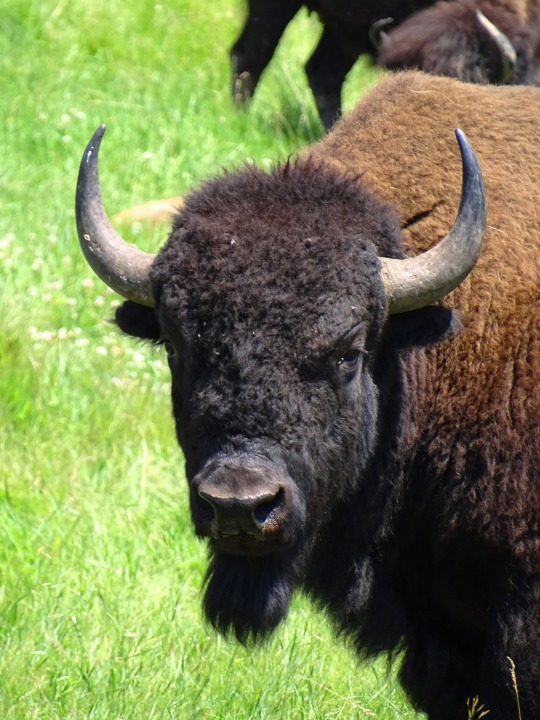

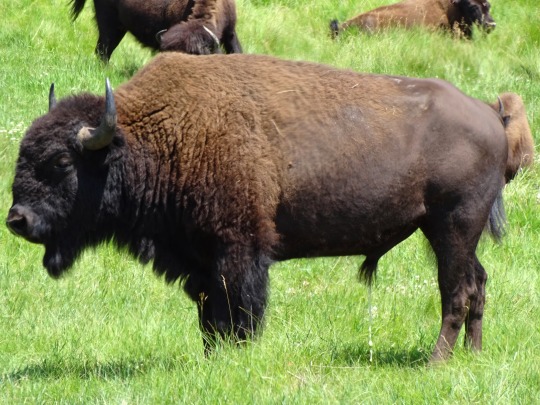

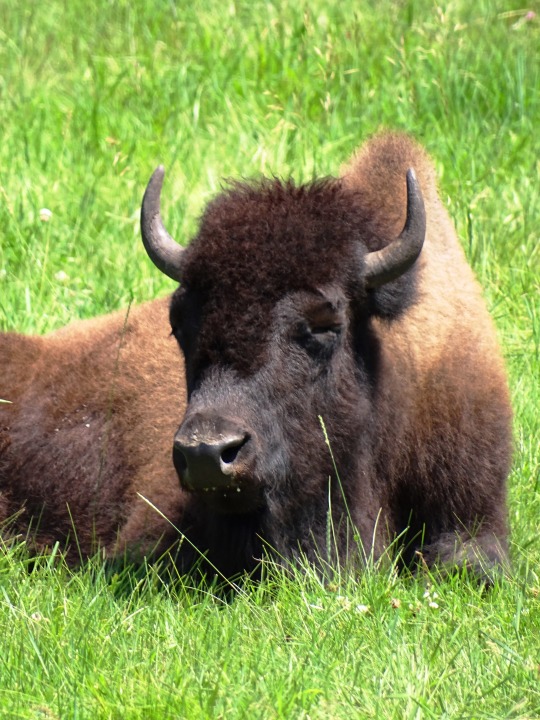
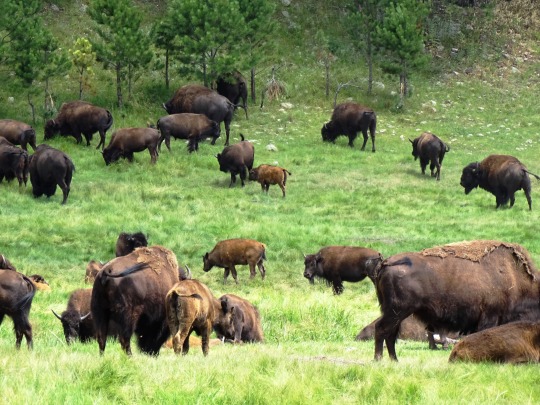
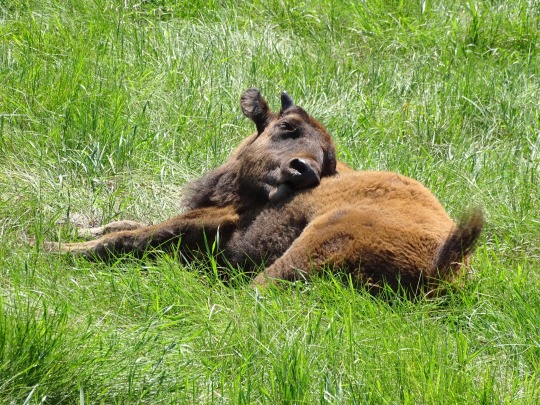

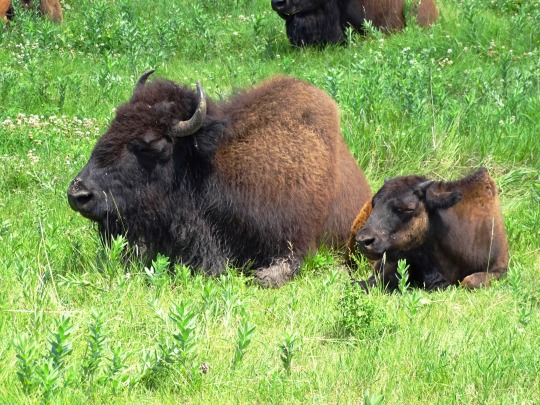
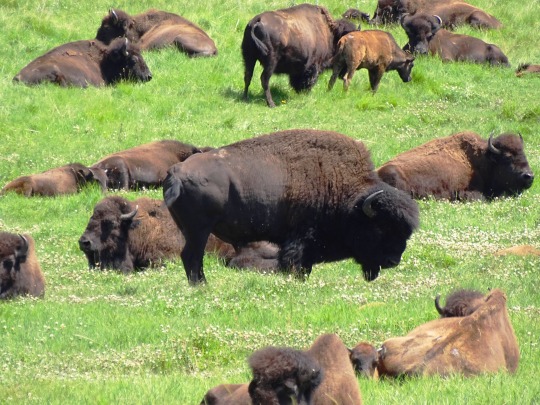
National Bison Day
You see them everywhere — on coins, on sports team logos, and a couple of state flags. No, we’re not talking about the bald eagle. This honor is reserved for North American bison. On National Bison Day, November 5, an annual event that falls on the first Saturday in November, all Americans should reflect on the impact bison have as a part of our environmental and cultural heritage. Bison are especially revered by Native people — central to their survival as both food and spiritual inspiration.
National Bison Day timeline
1900s Bison herds severely reduced due to excessive hunting and abuses
Hunting dramatically reduced the population — leaving a mere 700 in private herds; even Yellowstone was left with only 23 bison by 1902.
1992 Native American tribes formed new group to share resources and help bison
The InterTribal Indian Council formed not only to return bison to tribal lands, but also to create culturally-sensitive educational programs and provide both technical resources and help to 56 tribes.
1997 Groups signed Bison Memorandum of Understanding
The first conservation agreement between an environmental organization and a diverse collective of Native American tribes agreed to combine efforts to return wild bison to tribal land.
2012 The U.S. Senate passed first National Bison Day Resolution
The Senate passed its first resolution honoring National Bison Day, which was also supported by various tribal groups and the Wildlife Conservation Society.
How to Observe National Bison Day
Sign a petition
Visit a national park
Wear your National Bison Day T-shirt
Stand in support of returning wild bison to their original tribal lands on thousands of acres of Native American reservations. Collaborations among certain groups are working to remind Americans about the important role bison play in the lives of native peoples. Bison are considered sacred and they are even featured in certain tribal creation stories. Bison have also been a source of food and clothing — providing hides for tents, robes, shoes, and tools so that people could survive in harsh climates.
You may not be able to get to a large national park like Yellowstone, but there are a vast number of smaller parks from which to choose. Imagine what it must have been like to see thousands of bison freely roaming the plains. Give your children a chance to experience the wonder of our latest national icon — the bison.
Many groups use this day to raise funds in support of bison. It won’t be hard to find a T-shirt showing your love of bison. Wear it proudly because it’s for a great, patriotic cause.
5 Reasons We Love Our Bison
Watch that tail
They've got skills
They're oldies but goodies
Throw a stone — hit a bison
Bison as symbols
If a bison’s tail is hanging down and moves naturally from side to side, the animal is relaxed. But when the tail stands straight up, it's a signal the bison is getting ready to charge.
Given their size as the largest mammals in North America, bison are surprisingly agile with an ability to swim well, jump up to six feet, and run between 35 and 40 mph.
Bison have always roamed in Yellowstone National Park as evidenced by prehistoric fossils found in modern times.
Herds of bison can be found in all 50 states.
The American bison is not only the country's official mammal; the bison is also the state mammal of Wyoming, Oklahoma, and Kansas.
Why National Bison Day is Important
It's our national mammal
They're different from buffalo
They were almost extinct
President Obama, with the support of a broad coalition of Native American tribes, wildlife support groups, and concerned members of the Senate, signed a 2015 law making the proud and majestic bison our national mammal. This law helps to protect bison from extinction and encourages a return back to their native tribal lands.
We know you have been wondering about this so we're going to set you straight. Bison and buffalo are not the same. Bison are native to North and South America and Europe, while the traditional home of the buffalo is in Africa and Asia. At the height of their magnificence, there were between 30 and 60 million bison in the New World circa the 16th century. Today, there are currently half a million bison roaming happily across North America. .
Native peoples once lived their lives around the vast herds of bison that swirled around areas of the west and northwest, the central plains, and the southeastern U.S. Once pioneers started their westward trek, both the Native American tribes and the bison herds were seen as obstacles to progress. As the native peoples were systematically forced off their lands by either poachers or fake government treaties, the bison herds began to disappear; by the early part of last century, bison were on the way to extinction. Today, through the collective efforts of Indian tribes, wildlife associations, the national park system and others, bison have re-emerged as a protected species.
Source
#National Bison Day#first Saturday in November#5 November 2022#wildlife#animal#NationalBisonDay#American Bison#Buffalo#Bison bison#USA#Custer State Park#I love Custer State Park#Black Hills#South Dakota#travel#landscape#flora#fauna#wildflower#original photography#countryside#vacation#summer 2019#tourist attraction#landmark#meadow
62 notes
·
View notes